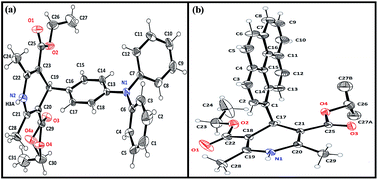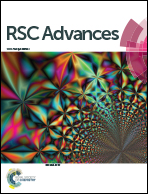Highly sensitive ratiometric fluorescence probes for nitric oxide based on dihydropyridine and potentially useful in bioimaging†
Abstract
Hantzsch dihydropyridine-based ratiometric fluorescent NO probes, viz. PyNO and TPANO, were synthesized and characterized. These two probes were shown to be selective and sensitive for NO among the reactive oxygen/nitrogen species (ROS/RNS) studied in HEPES buffer medium by absorption, fluorescence, and visual color change with detection limits of 2.6 μM and 0.08 μM, respectively. Nitric oxide (NO) reacts with Hantzsch dihydropyridines to give the corresponding intensely fluorescent product pyridines via aerobic oxidation and this is applied to detect nitric oxide (NO). A reaction mechanism for dihydropyridine with NO is proposed in this study. The probe shows good stability over a broad pH range (pH > 4). The structures of the PyNO and TPANO probes have been established by single-crystal XRD. DFT and TDDFT calculations were done to demonstrate the electronic properties of the probes and their aromatic products. Moreover, the utility of the PyNO and TPANO probes in detecting NO in live cells has also been demonstrated using Vero cells as monitored by fluorescence imaging. A study of the detection of endogenously generated NO was also carried out by increasing the incubation time of the probe with lipopolysaccharide (LPS) pre-treated cells and it was found that a highly fluorescent cell image could be obtained.


 Please wait while we load your content...
Please wait while we load your content...